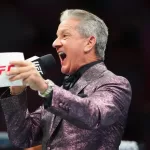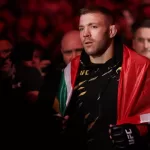THE last two Jon Jones fights were for the hardcore fans or the masochists in the MMA audience. Both were against former middleweights whose success at light heavyweight was taken more as a confirmation of how sloppy and short on talent that division has become in recent years.
Anthony Smith’s attempt at Jon Jones’ title was a tedious, lop-sided loss, while Thiago Santos managed to come within inches of dethroning the champ—dropping a controversial decision—but left almost no one clamouring for a rematch. Yet those two slogs were booked to fill Jones and the UFC’s schedules. In the background, the UFC was seasoning one of the most exciting light heavyweight prospects in years and after what seems like an eternity, Dominick Reyes gets his shot at Jon Jones this Saturday at UFC 247.
Reyes satisfies the fashion for fans differentiating between “athletes” instead of “fighters” and he is more than willing to point this out himself. He had a decent American football run through college, and at six foot four he is one of the larger men who can make the cut to two hundred and five pounds comfortably. His height and his almost eighty inch reach are the attributes which draw the most attention because Jones’ own height and reach are so often credited for his success.
Dominick Reyes, one of the greatest athletes in Apple Valley history. Being a big fish in a small pond for so long has really gone to his head.
— Jon Bones Jones (@JonnyBones) February 3, 2020
Jones’ reach isn’t impacting his fights in the same way Lennox Lewis’ or Sonny Liston’s did. The art of boxing is 50% what you do with your hands and your head, and 50% what your feet are doing, where you are in the ring, and your anticipation of your opponent. When it comes to that latter half, Jones might be one of the best boxers MMA has ever had. It is just that when Jones actually throws his hands they are a flappy mess. When bitter fans recount that Jones’ alien eighty-four inch reach is winning his fights for him, they don’t mean that he is jabbing people’s faces off, mostly he uses his reach to frame, push, and—sadly—poke eyes.
Unimpressive showings on the feet against Alexander Gustafsson and Ovince St. Preux—two men of similar stature to Jones—have added to the idea that if Jones doesn’t thrive on his reach advantage alone, he at least suffers when opponents aren’t swinging up at him.
Reyes is more than his build and some athletic credentials though. Gustafsson had good success against Jones in their first fight by boxing in combination and using jabs and body jabs to set up further shots, thriving on volume. In the rematch with Gustafsson, Jones worked to cut off the Swede’s combos before they got going. Jones did this by fighting on the back foot and circling out—forcing Gustafsson to keep turning and following—and by closing into clinches when Gustafsson overcommitted. Reyes’ style stands in contrast to Gustafsson’s as Reyes is more of a sharp shooting, single shot sort of fighter with a bit more pop in his punches, who has a more active kicking game than Gustafsson.
There are some marked similarities between Reyes’ minimalist striking game and that of Mirko ‘Cro Cop’ Filipovic who had success in PRIDE through the early 2000s. Like Cro Cop, Reyes is a southpaw who thrives with the left straight and the left round kick. This is what is called a double attack—two strikes which have similar telegraphs but different targets or paths. Ultimately the point is to put the opponent to a choice in the instant between the start of the attack and its connection. Good round kicks force the opponent to crunch his elbows down to his sides and expose him to the left straight up the centre line. A good left straight has the opponent reaching to parry or trying to slip to the elbow side, both of which expose him (or even lean him into) the left high kick or body kick.
Reyes kicks the lead leg far more than Cro Cop—who used to point out that one bad low kick and you break your foot, but one good body or head kick and the fight is over. Reyes’ confident low kicking probably puts him in better stead for this match up with Jones though, as Thiago Silva just had great success in a pure low kicking match against the light heavyweight champ. The slide back to the left and counter left straight that Reyes is constantly looking for says Filipovic all over it.
In order to operate this sort of sharpshooting style consistently, you need to have some weight behind your punches, but you also need to be able to manage the distance and look after your space. That is probably the most compelling part of the Jones versus Reyes match up because so much of Jones’ success has hinged on his footwork and ringcraft. Jones’ rematches with Daniel Cormier and Gustafsson were marked by long periods of leading his man around the ring and kicking them in the body and legs as he timed their step towards him, then cutting an angle and forcing them to turn before they could get their strikes going in combination.
You can probably rely on Jones to use the same sort of tactics he used against Gustafsson in the second fight here. He will likely alternate between picking with kicks at range, and ducking into clinches and threatening takedown attempts. We have seen a few fighters try to force grappling on Reyes and he has been fairly good at turning himself off the fence and breaking from clinches. However, Jones is a much more accomplished striker from the clinch than anyone Reyes has been in with and often uses the clinch just to lean on his man, post his head under theirs, and set up body strikes or elbows to the head. Very scary hitters like Glover Teixeira and Cormier have been pushed to the fence and beaten up with their feet level and butt pressed to the fence by Jones.
We have waited quite a while for Reyes to get to this point and it seems that his team have been keen to have him tested a little before diving into the Jones fight. Reyes’ most recent fight—against a Chris Weidman who is well beyond his sell-by date—told us very little but bouts against Ovince St. Preux and Jared Cannonier were pretty convincing but they were very much one trick ponies. Reyes’ only stumbling block was against Volkan Oezdemir who brought the kind of rounded grappling-to-striking and striking-to-grappling offence that you are more likely to see from Jones. Yet with all the healthy scepticism towards Reyes, there are just as many questions around Jones at this point who looked frankly bad in his last showing. Reyes might not be the earth-shattering talent that some have advertised him as, but he might still catch Jones just as he’s getting too long in the tooth to hold onto his crown.



